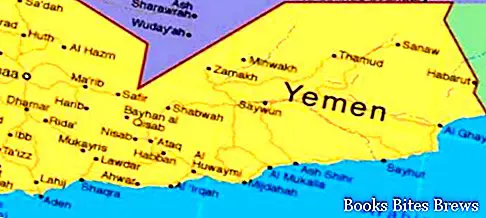Yemen tourist guide, practical information to go to this state of Africa, how to get there and the best times to visit it.
Yemen in short
- Capital: San’a
- Surface: 527.970 sq km
- Inhabitants: 23.085.000
- Religion: Sunni Islam
Geography
Yemen is a state located at the southern end of the Arabian Peninsula, its official name is the United Republic of Yemen. It borders Saudi Arabia to the north, Oman to the east, and is bathed in the west by the Red Sea and in the south by the Gulf of Aden, the Indian Ocean.
The Socotra archipelago in the Indian Ocean and the Zucur-Hanish archipelago and the Perim and Kamaran islands in the Red Sea also belong to the republic of Yemen.
The territory of Yemen rises on average above 2000 meters above sea level, includes almost 2000 km of coastline and, compared to other countries in the Middle Eastern area, stands out for the variety of natural environments.
In the western section of Yemen, the plateau overlooking the Red Sea, whose maximum altitude exceeds 3500 meters s.l.m., is engraved by a series of valleys that descend on the coast characterized by a coastal strip partly alluvial and partly hilly.
The plateau, proceeding inland, slopes to the east assuming a desert character while a strip of the Rub'al Khali, a vast desert of red sands, occupies the northern end.
The plateau regains altitude in the central-eastern and southern part of the country, with reliefs on 2000-2500 meters above sea level. which follow one another in steep escarpments towards the Gulf of Aden, giving way to a narrow and flat coastal strip.
Hydrography
Yemen's poor hydrographic network is characterized by temporary waterways called uidians.
The main river is the wadi hadramawt which, at the bottom of its course, has a perennial flow of water which is called Wadi Masilah.
Climate
The climate of Yemen is mainly tropical dry, with high temperatures mitigated by altitude.
Precipitation, concentrated in the summer months, mainly affects the mountainous areas, favored, from a climatic point of view, compared to the rest of the territory.
Recommended readings- Sanaa (Vietnam): what to see in the ancient capital
- Yemen: useful information
- Socotra (Yemen): what to see on the island
Population
The population is made up almost entirely of Arabs, and minorities of Somalis, Asians and a small number of Europeans.
Time zone
The time zone is 2 hours ahead of Italy and 1 hour ahead when daylight saving time is in effect in Italy.
Tongue
The official language of Yemen is Arabic.
Economy
Yemen is the poorest country in the Arabian Peninsula, the population mostly lives in rural areas and is mainly employed in agriculture,
sector that is affected by environmental limitations and has little relevance for the production of GDP.
The main agricultural products are coffee and cotton.
Almost all exports relate to oil, although in recent years it has suffered a sharp drop.
Tourism has significant development potential, especially in historical and archaeological sites, on the coast and in the islands, but has difficulty in establishing itself.
When to go
The best months to visit Yemen are April, May and September, October.
Necessary documents
To travel to Yemen you need a passport with residual validity of at least six months from the date of entry into the country. An entry visa is required and is issued by the Yemen Embassy in Rome.
Phone
- The international prefix for calling from Italy to Yemen is: 00967
- The international prefix for calling from Yemen to Italy is: 0039
With GSM 900 and CDMA mobile phones, you can call from most Yemeni cities.
GSM and CDMA networks cover more than half of the country, although in mountainous areas and in more isolated areas, reception is often difficult.
Internet cafes are easily found in major cities.
Electricity
The electric current in Yemen is 110/220 volts.
It is advisable to have an American type socket adapter. In some areas the grid frequency is not very stable.
Money and credit card
The official currency of Yemen is the Riyal.
Exchange offices are located in all cities of Yemen, and the foreign currencies that change most easily are the US dollar and the euro.
There are ATMs in banks, but unreliable for foreign cards.
The main credit cards are accepted in luxury hotels, by the airline Yemenia and by some tour operators.
How to get
plane
There are no direct flights from Italy to Yemen.
The main Yemeni airline is Yemenia with which, from Rome via Frankfurt, it is possible to reach the capital San’a.
Other airlines connecting Italy to San’a are Turkish Airlines with a stopover in Istanbul, EgyptAir with a stopover in Cairo, Emirates Air with a stopover in Dubai, Qatar Airways with a stopover in Doha.
Vaccinations
No mandatory vaccinations are required to enter Yemen.
The yellow fever vaccination certificate is required only from travelers over the age of one year from infected areas.
After medical consultation, vaccinations against typhoid, hepatitis A and B, polio, diphtheria, tetanus and meningitis are recommended.
The risk of malaria exists all year round, especially from September to February, below 2000 meters.
There is no risk of malaria in Sana'a.
It is appropriate to follow some hygienic measures, drink only bottled water without adding ice, eat only cooked meats and vegetables, fruit only if peeled personally.
Before departure, it is recommended to take out health insurance that covers medical costs and a possible repatriation.




